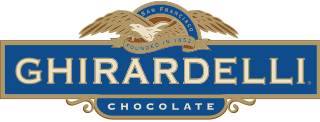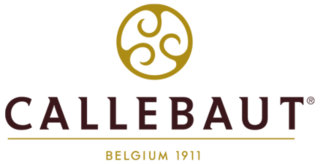
Chocolate or cocoa is a food made from roasted and ground cacao seed kernels that is available as a liquid, solid, or paste, either on its own or as a flavoring agent in other foods. Cacao has been consumed in some form since at least the Olmec civilization, and later Mesoamerican civilizations also consumed chocolate beverages before being introduced to Europe in the 16th century.

The cocoa bean or simply cocoa, also called cacao, is the dried and fully fermented seed of Theobroma cacao, from which cocoa solids and cocoa butter can be extracted. Cocoa beans native to the Mexican pre Colombian territory were extended to Ecuadorian Amazon rainforest and are the basis of chocolate and Mesoamerican foods including tejate, an indigenous Mexican drink.

The Hershey Company, often called just Hershey or Hershey's, is an American multinational confectionery company headquartered in Hershey, Pennsylvania, United States, which is also home to Hersheypark and Hershey's Chocolate World. The Hershey Company is one of the largest chocolate manufacturers in the world; it also manufactures baked products, such as cookies and cakes, and sells beverages like milkshakes, as well as other products. The Hershey Company was founded by Milton S. Hershey in 1894 as the Hershey Chocolate Company, originally established as a subsidiary of his Lancaster Caramel Company. The Hershey Trust Company owns a minority stake but retains a majority of the voting power within the company.

A chocolate bar is a confection containing chocolate, which may also contain layerings or mixtures that include nuts, fruit, caramel, nougat, and wafers. A flat, easily breakable, chocolate bar is also called a tablet. In some varieties of English and food labeling standards, the term chocolate bar is reserved for bars of solid chocolate, with candy bar used for products with additional ingredients.

The Ghirardelli Chocolate Company is an American confectioner, wholly owned by Swiss confectioner Lindt & Sprüngli. The company was founded by and is named after Italian chocolatier Domenico Ghirardelli, who, after working in South America, moved to California. The Ghirardelli Chocolate Company was incorporated in 1852, and is the third-oldest chocolate company in the US, after Baker's Chocolate and Whitman's.

Callebaut is a chocolate brand, owner of the company is Barry Callebaut group, and based in Belgium. It was founded in 1911 by Octaaf Callebaut in Belgium.

Chocolate is a food product made from roasted and ground cocoa pods mixed with fat and powdered sugar to produce a solid confectionery. There are several types of chocolate, classified primarily according to the proportion of cocoa and fat content used in a particular formulation.
Joseph Schmidt Confections was a San Francisco-based chocolatier, which created gourmet confections with imported Belgian chocolate. The line of confections included truffles of various sizes, slicks, and mosaics. Joseph Schmidt confections ceased operations in 2009.
Dagoba Organic Chocolate was a brand of chocolate founded in 2001 by Frederick Schilling. The Hershey Company acquired Dagoba in 2006 but in June 2021 Dagoba again became a privately held company. Hershey divested the Dagoba chocolate brand along with Krave Pure Foods and Scharffen Berger in order to focus on the salty snacks and nutrition bars markets.. After the divesture, Scharffen Berger moved production and its headquarters to the Dagoba factory in Ashland, Oregon and registered in 2021 as an LLC with the Oregon Secretary of State. However, Dagoba did not re-register in Oregon as a business entity and the Dagoba home page redirects to the Hershey site.
Barry Callebaut AG is a Swiss-Belgian cocoa processor and chocolate manufacturer, with an average annual production of 2.3 million tonnes of cocoa & chocolate . It was created in 1996 through the merging of the French company Cacao Barry and the Belgian chocolate producer Callebaut. It is currently based in Zürich, Switzerland, and operates in over 30 countries worldwide. It was created in its present form by Klaus Johann Jacobs.
TCHO is a chocolate maker based in Berkeley, California, US that promotes itself as working with cacao bean farmers and cooperatives to improve growing, fermentation and drying methods. Its factory and headquarters were formerly located on Pier 17 along the Embarcadero, in San Francisco's historic waterfront district, but are now located in the West Berkeley section of Berkeley, California. In February 2018, it was announced that TCHO would be bought by the Japanese confectionery company Ezaki Glico.
Robert Wayne Steinberg was an American physician who co-founded Scharffen Berger Chocolate Maker in 1996 with John Scharffenberger, his friend and former patient.
The following outline is provided as an overview of and topical guide to chocolate:

Fair trade cocoa is an agricultural product harvested from a cocoa tree using a certified process which is followed by cocoa farmers, buyers, and chocolate manufacturers, and is designed to create sustainable incomes for farmers and their families. Companies that use fair trade certified cocoa to create products can advertise that they are contributing to social, economic, and environmental sustainability in agriculture.

A chocolaterie is a type of business which both manufactures chocolate confections and sells them, at the same location. It is usually a small family business, often operating at only one location. The word is of French origin, and shops named as such are common in France and Belgium. The term is also used to designate larger chocolate production companies, such as Chocolaterie Guylian, many of which started as smaller shops. This type of store operates in other countries, such as the US, Canada, the UK and Germany, sometimes using the French term. Stores which sell candies and chocolate but do not produce their own brand are called confectionery stores, or other names depending on the region. The related occupational term is chocolatier, though this term is also used sometimes to describe chocolateries, such as Godiva Chocolatier.

Organic chocolate is chocolate which has been certified organic. As of 2016, it was a growing sector in the global chocolate industry. Organic chocolate is a socially-desirable product for some consumers. Major brands, such as The Hershey Company, have begun to produce organic chocolate.

Bean-to-bar is a trade model in which a bean-to-bar chocolate manufacturer controls the manufacturing of chocolate from the procurement of beans to the creation of the end product of consumer chocolate.













